Modeling of Interactive Teaching and Learning System for Students Based on Artificial Intelligence
Abstract
In order to improve the interactive effect of modern teaching, this paper combines the artificial intelligence interactive technology to model the teaching interactive process and designs and analyzes the system static test of the infrared feature threshold online monitoring system. Moreover, this paper performs beam-expanding shaping on the output feature and increases the shaping optical path and the uniform optical path to make the infrared spot energy distribution relatively uniform and reduce the error when observing the loss threshold. The software part takes the spot shift threshold and quadrant amplitude threshold as the design basis of the upper computer threshold judgment algorithm. In addition, this paper designs an interactive teaching and learning system for students based on artificial intelligence. The research results show that the interactive teaching and learning system for students based on artificial intelligence has an obvious role in promoting modern teaching.
1. Introduction
At present, the content of teacher-student interaction in online teaching is only superficial. This is mainly reflected in the design of interactive problems and the depth of teachers and students’ discussion of the problem. First, the question design of teacher-student interaction is relatively simple, and there is a lack of questions that can promote deep understanding and knowledge transfer. At present, the design of teaching problems is mainly based on “what” questions and less on “why and how” questions. That is to say, there are many problems of memorization and few problems of analysis, synthesis, evaluation, and innovation. Second, the discussion between teachers and students on interaction issues is superficial [1]. The survey found that the teacher-student interaction content in online teaching is mainly based on teacher guidance. In the interaction, the students mainly expressed their gratitude to the teachers for their guidance and lacked depth in the discussion of the problem. Moreover, the content of teacher-student interaction in online teaching is superficial, and it is difficult to induce students’ in-depth learning and in-depth understanding of the problem. As we all know, whether the interactive content of teachers and students in online teaching is superficial is related to teachers’ understanding of interaction, teachers’ information technology knowledge and ability, and whether classroom interaction issues can stimulate students’ interest [2]. Teachers’ perception of interaction affects the design of interactive content. Because teachers do not have a deep understanding of the meaning of interaction, they often regard the interaction as a tool to test students’ knowledge, or as a “seasoning” for the classroom atmosphere. Therefore, when designing interactive questions, they tend to ask descriptive questions to understand the students’ mastery of classroom knowledge, or ask simple questions to activate the classroom atmosphere [3]. The reason is that teachers do not realize that the careful design of interactive questions can not only make teaching develop in the expected direction, but also cultivate students’ thinking ability and achieve effective learning. While online teaching creates a convenient and diversified teaching environment for teachers and students, it also brings new requirements and challenges to teachers. At the same time, online teaching requires teachers to have information technology knowledge and ability and design interactive problems at different levels on the basis of adapting to the new teaching form [4]. The survey shows that teachers have a lot of anxiety about online teaching, and the main anxiety points are distributed in three aspects: interaction with students, equipment operation, and teaching organization. At the same time, in the process of online teaching design, management, and implementation, teachers lack the ability to apply educational technology and integrate information resources [5]. In the process of online teaching, teachers often reduce interactive links or ask questions with low cognitive level to ensure the completion of teaching tasks. Finally, because the interactive problem is relatively simple, it does not require too much thinking and discussion, and it does not arouse students’ interest in interactive participation. In the end, in addition to answering basic questions, students are more likely to participate in the interaction with polite expressions of thanks, and teachers and students have no depth in the discussion of questions [6].
The single use of teacher-student interaction methods in online teaching is related to whether teachers master the knowledge and skills of online teaching, whether students participate in interaction in an orderly manner, and whether teachers and students are well prepared for group cooperation. Among them, teachers’ knowledge and skills in online teaching affect the choice of interactive mode [7]. As a new type of teaching method, online teaching not only requires teachers to be familiar with the application of network platforms, fully understand the advantages and operating conditions of each interactive method, but also requires teachers to prepare teaching materials in advance. Respond to emergencies such as freezes and black screens [8]. However, at present, due to the lack of information literacy of teachers, lack of understanding of various interaction methods, and unfamiliarity with specific operations, teaching interaction is mostly conducted in simpler and direct ways such as voice connection to microphone and video connection. At the same time, online teaching in an emergency state has caused students to not adapt to the new teaching form, and the order and rules for online teaching interaction and participation have not yet been established in the class, so students often swipe the screen and speak at will when participating in the interaction, which leads to disorderly interaction in online classrooms occurs. Therefore, in order to improve teaching efficiency and ensure the successful completion of online teaching tasks, teachers usually choose a simple and direct way to interact [9]. Also, online group discussions are very different from offline group discussions. In offline teaching, group discussions are more interactive methods, because group discussions are conducive to cultivating students’ sense of cooperation, enhancing students’ enthusiasm and participation, and promoting the occurrence of deep learning. However, in online teaching, in order to control the rhythm of the classroom, teachers generally seldom use the interactive form of group discussion. Because of the efficient operation of group discussions, teachers need to make more preparations in advance. For example, allocate study groups reasonably and establish different group forums; formulate rules for online interaction and participation; issue group tasks in advance; group leaders collect and organize the opinions of all students in the group, etc. In online group discussions, teachers cannot monitor the discussion of each group at any time like offline teaching, which undoubtedly increases the difficulty of teachers’ management. Therefore, in order to complete the teaching task in the limited classroom, teachers seldom use the interactive form of group discussion [10].
The sense of distance in online teaching will increase the difficulty of creating an atmosphere. For example, network anchors will strive to create an atmosphere in terms of setting, language, and interactive methods, and care for the fan group. The leaders in the industry have very good empathy skills. Teachers can also learn from this in the process of implementing online teaching. The so-called “empathy” is actually the ability to experience the hearts of others, convey their own empathy to the other party, influence the other party, and obtain feedback [11]. Empathy is the foundation of teacher-student communication. If teachers can empathize with students, students will be more willing to open their hearts to teachers. Teachers can listen to potential information and main problems from students’ expressions, obtain key information, and then improve the communication effect [12]. To improve empathy, teachers communicate with students in a state of empathy. They need to improve their awareness from a subjective perspective, observe students’ behavior more consciously, use more accepting and encouraging language, and use less criticism, blame, or language difficult for students to accept. This is what San Dong Nuan said. Especially at this stage, students have strong self-awareness. They can solve problems in a roundabout way and express criticism of students in encouraging language. This is the art of language, and it is also a teaching skill that teachers should master [13].
A good learning environment can mobilize the enthusiasm of students to learn independently. The environment includes soft environment and hard environment. In online teaching, teachers can have a positive impact on the soft environment. To do this well, teachers need to be prepared in advance for learning statistics. For example, it implements real-time teaching monitoring for students, collects feedback information, handles students’ mutual evaluation and complaint reports, and designs process evaluation plans [14]. In addition, when students learn independently, teachers need to maintain the order of online learning, organize students to build a community of mutual help and common learning, and guide students with high self-learning efficiency to guide students with low learning efficiency. For example, using the “study statistics” included in the Learning Link platform, students with outstanding performance and relatively backward students can be formed into study groups, allowing them to help each other and promote improvement. Multiperson mutual assistance in study groups can enable students to complete learning tasks in the process of supervising and helping each other and increase students’ sense of achievement. This measure is often used in the teaching process and has achieved expected results [15].
The basic elements of classroom teaching structure are teachers, students, teaching content, teaching equipment, and teaching media. How to organically combine these elements to form the best structure and achieve the best teaching effect is the focus of online teaching structure layout. As an important evaluation and positioning method, the difficulty of examination and the setting of evaluation method often have a result-oriented impact on students’ daily learning focus [16]. In the selection of evaluation methods, the evaluation of knowledge and nonknowledge ability should be distinguished, and both aspects should be considered comprehensively. In the teaching process, it is also necessary to do the following links to attract students and obtain students’ recognition in content arrangement, structure arrangement, examination method, and other links, so as to improve their awareness of active participation [17].
The teaching plan design concept is guided by teachers, creating a learning space that students like, so that students can choose independently to develop their personal potential and actively participate in the teaching environment. The teaching plan should be in line with the cognitive characteristics of students, and the focus should be on three types of questions, namely, retrospective questions, exploratory questions, and summative questions, to help students recall the existing cognitive structure before learning new knowledge, so as to better understand the old and new knowledge and to establish connections between students and deepen students’ knowledge and understanding [18].
This paper combines artificial intelligence interactive technology to model the teaching interaction process to improve the effect of artificial intelligence interactive teaching.
2. Digital Modeling of Interaction Models
2.1. Interactive Classroom Online Infrared Monitoring Based on Infrared Recognition Threshold of Scattered Light
In the case of an ideal gas, the coefficient of thermal expansion takes the simple form αp = (1/T).
Among them, p is the pressure (SI unit Pa) and Q includes heat sources other than viscous dissipation (SI unit W/cm').
In the formula, p represents density (SI unit kg/mxi), u represents the velocity vector (SI unit m/s), p is the pressure (Sl unit Pa), and F is the body force vector (SI unit N/m3).
Formula (7) is a continuity formula, representing the conservation of mass, and formula (8) is the conservation of momentum.
Here, ϕ is the interface tracking variable, λ (SI unit: N) is the mixing energy density, and e (SI unit: m) is expressed as the capillary width proportional to the interface thickness. These two parameters are related to the surface tension coefficient o by the formula. Fst and F represent interfacial tension and external volume stress, respectively.
2.2. Theoretical Basis for the Effect of Ablation Topography on the Scattering Light Field of Illumination Light
When the illumination light irradiates the target, its scattered light field will change, and the numerical calculation needs to use the governing equation and the modified equation in geometrical optics.
These first-order equations for ray trajectories are only valid over many wavelengths away from any point source, ψ ≫ 1.
Here, k = kc, where kc is the ray vector wave when hitting the wall.
2.3. Overall System Plan
The overall schematic diagram of the system for online monitoring of infrared identification threshold based on scattered light is shown in Figure 1. It mainly includes a typical target frame, an illumination light system, an infrared system for defects, a four-quadrant detection system, and a program-controlled computer and software system.
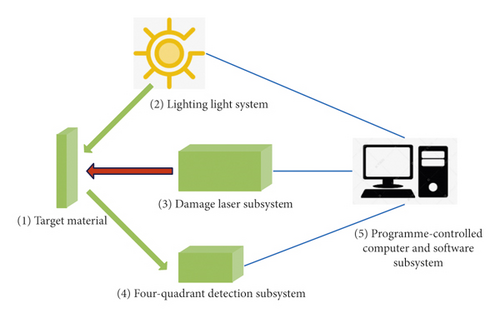
The target holder (1) is mainly used to place typical targets and is an XYZ three-dimensional translation stage, which can realize the selection of the target action point position. The illuminating light subsystem (2) is used for illuminating the infrared identification area and characterizing the defects of the target material through the scattered light of the illuminating light. The infrared device subsystem for defects (3) is a high-power infrared device for target defects, which is used to measure the defect threshold of the target. The four-quadrant detection subsystem (4) receives the scattered light of the illumination light and judges whether the target material to be tested is defective or not according to the characteristics of the scattered light. There are three main functions of the program-controlled computer and software subsystem (5). That is, the four-quadrant detection subsystem is used to evaluate the infrared identification of typical targets, control the infrared output power of the infrared device subsystem for defects, launch and stop, and control the modulation of the illumination optical subsystem. Through these subsystems, the system structure distribution of the established infrared recognition threshold online monitoring based on scattered light is shown in Figure 2.
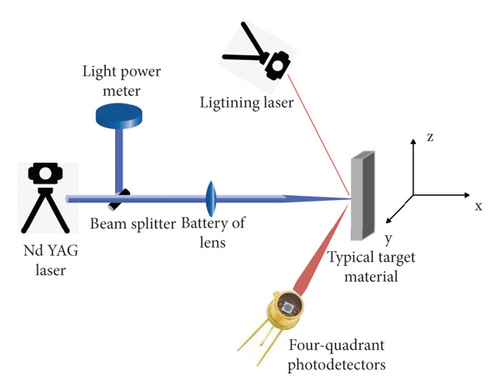
2.4. System Hardware Design
Aiming at the online monitoring experiment of infrared recognition threshold, the system has researched and designed the optical part and the electrical part of the hardware design, respectively.
2.4.1. Infrared Identification Monitoring System
The infrared light emitted by the illuminating light infrared device is shaped by the lenses (5) and (6), focused on the surface of the aluminum target, and then reflected by the surface of the aluminum target to form scattered light. After that, the scattered light is focused by lens (1) and lens (3) and received by the four-quadrant photodetector. Its specific optical path is shown in Figure 3.
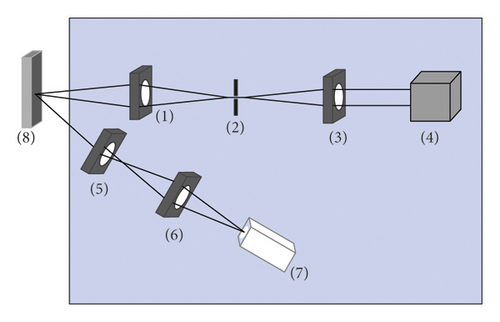
(1), (3), (5), and (6) are focusing lenses, (2) are diaphragms, (4) are four-quadrant detection systems, (7) are illuminating infrared devices, and (8) are target t650 nm. The infrared device is used to locate and monitor the defect area of the aluminum target in real time, so as to achieve the purpose of online monitoring.
The infrared device subsystem for defects includes optical fiber infrared device (wavelength 1064 nm) beam expanding, collimating, and focusing optical system as shown in Figure 4.
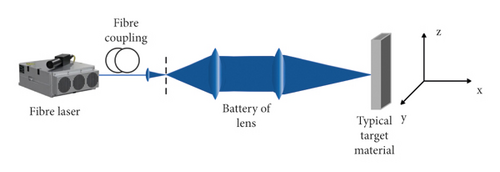
Here, λ is the infrared wavelength, D is the diameter after beam expansion, and f is the focal length of the focusing lens. Then, according to the above parameters, the diameter of the infrared spot after focusing is 5.8 µm. In fact, due to the influence of diffraction, aberration, focal length position, etc., the diameter of the focal spot at the target is larger than this.
The design of the circuit system includes photoelectric conversion circuit of photodetector, weak signal preamplifier, filter circuit, sum-difference operation circuit, division operation circuit, analog/digital conversion circuit, etc. The overall circuit framework is shown in Figure 5.

Here, k is the conversion coefficient between voltage and position, and V1, V2, V3, V4 is the corresponding output voltage of the four PIN photodetectors, respectively. From this, the center position of the light spot on the detector can be obtained.
2.4.2. Noise Processing in the Photoelectric Amplifier Circuit
The main problem in the photoelectric detection system is to solve the photoelectric conversion part and the electrical signal processing part. In the electrical signal processing part, the first problem to be solved is the problem of signal noise processing. In the photoelectric detection system, the noises that often appear mainly include thermal noise, shot noise, G-R noise, current noise, and background noise.
Here, i represents the shot noise current, 4 represents the charge, I represents the average current, and 4f represents the change of the bandwidth. Since the shot noise is white noise, it can be ignored in the system design.
Here, Ad represents the area of the detector, and I represents the average current. For the photodetector, when the current noise is large, the noise can also be reduced by means of mean filtering.
Finally, the background noise is the noise information generated by the photodetector in the process of detecting the signal, when the stray light around its environment also affects it. The influence of background noise can be avoided by receiving in an optical darkroom environment or after adjusting the effective optical signal.
2.4.3. Selection of Photodetectors
By analyzing the current domestic device models and miniaturization conditions in the existing experimental environment, the selected four-quadrant photodetector model is 500741. The detector has low noise and high stability, the wavelength range is 400–1100 nm, the photosensitive surface is 7.8 mm, the response time is 40 ns, the bandwidth is 10 MHz, and the reverse bias voltage is 12 V. Moreover, it is widely used in domestic photoelectric detection and optical signal orientation determination. Figure 6 shows the wavelength response range of the photodetector.
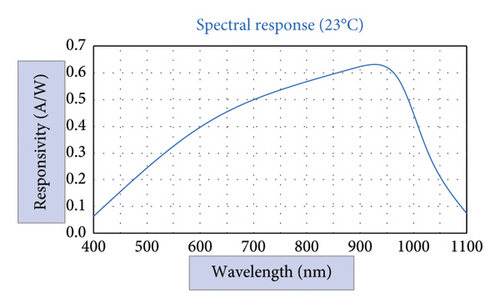
Here, Ii is the input current, Vout is the output voltage, Ib is the current input to the reverse end of the operational amplifier, and Rin is the internal resistance of the operational amplifier. It can be analyzed through the above formula that the output signal has a certain relationship with the input impedance R. More importantly, it is related to the selection of resistor R and T-type network resistor. The value of R can be larger and the value of R resistance is smaller. At this time, the sensitivity of weak current measurement will be significantly improved. It can be concluded that the use of T-type I–V conversion circuit in the detection process of weak current signal can not only improve the detection sensitivity, but also compared with the method of resistance sampling, this method can obviously reduce the noise in the circuit.
3. Interactive Student Teaching and Learning System
This paper combines the algorithm of the second part to construct the interactive teaching and learning system for students. The composition of the distributed interactive teaching system includes a classroom site and multiple equipment sites. Classroom and equipment site includes 7 other parts, namely, Cliker system (student classroom response system), interactive double whiteboard teaching system, high-definition camera and equipment terminal display lead system, equipment site dual-screen display system, high-definition recording and broadcasting system, two-way voice transmission system, and mobile instrument cart system with high-definition camera, as shown in Figure 7.
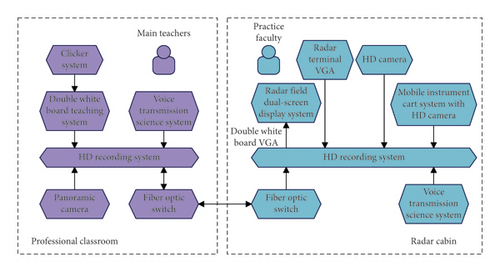
The recognition image obtained by the infrared interaction algorithm in this paper is shown in Figure 8.
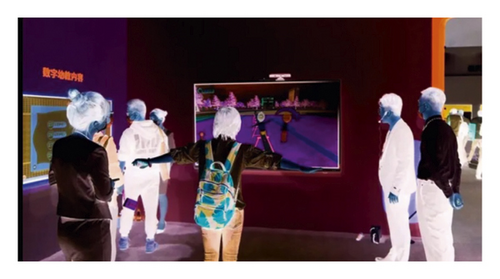
The effect of the artificial intelligence-based interactive teaching and learning system for students proposed in this paper is verified, and the improvement effect of this system on the teaching quality is evaluated, and the evaluation results shown in Table 1 are obtained.
| Number | Boost effect |
|---|---|
| 1 | 79.78 |
| 2 | 85.86 |
| 3 | 81.82 |
| 4 | 79.72 |
| 5 | 83.15 |
| 6 | 83.26 |
| 7 | 78.84 |
| 8 | 78.75 |
| 9 | 80.35 |
| 10 | 78.37 |
| 11 | 78.34 |
| 12 | 81.81 |
| 13 | 78.90 |
| 14 | 83.30 |
| 15 | 81.26 |
| 16 | 81.27 |
| 17 | 80.27 |
| 18 | 85.47 |
| 19 | 80.97 |
| 20 | 84.66 |
| 21 | 85.81 |
| 22 | 81.95 |
| 23 | 83.68 |
| 24 | 79.63 |
| 25 | 78.98 |
| 26 | 80.95 |
| 27 | 79.29 |
| 28 | 79.46 |
| 29 | 79.59 |
| 30 | 81.58 |
| 31 | 83.07 |
| 32 | 81.43 |
From the above research, it can be seen that the interactive teaching and learning system based on artificial intelligence has an obvious role in promoting modern teaching.
4. Conclusion
In online teaching, interactive content affects the effect of interaction, and the breadth and intensity of knowledge flow are positively correlated with the level of interaction. Among them, the main form of interactive content is the questions raised by teachers or students, and the design of interactive questions is extremely important for the effective interaction of online teaching. In addition, in the process of online teaching, teachers should not only provide students with simple questions or basic skill exercises, but also design deeply interactive content to enhance the breadth and intensity of knowledge flow. Thus, students learn to deal with complex, comprehensive, and challenging problems. At the same time, teachers need to guide students to carry out deep cognitive processing, so as to achieve the effect of deep learning. This paper combines artificial intelligence interactive technology to model the teaching interaction process to improve the effect of artificial intelligence interactive teaching. The research shows that the interactive teaching and learning system based on artificial intelligence for students has an obvious role in promoting modern teaching.
Conflicts of Interest
The authors declare no conflicts of interest.
Acknowledgments
This work was supported by the Key Research Topic of the Self-Examination Branch of the Higher Education Association: Research on the Construction of the Network-Aided Model for Higher Education Self-Examination Examination under the Background of Internet + (No. 21ZKB04).
Open Research
Data Availability
The labeled dataset used to support the findings of this study is available from the corresponding author upon request.




